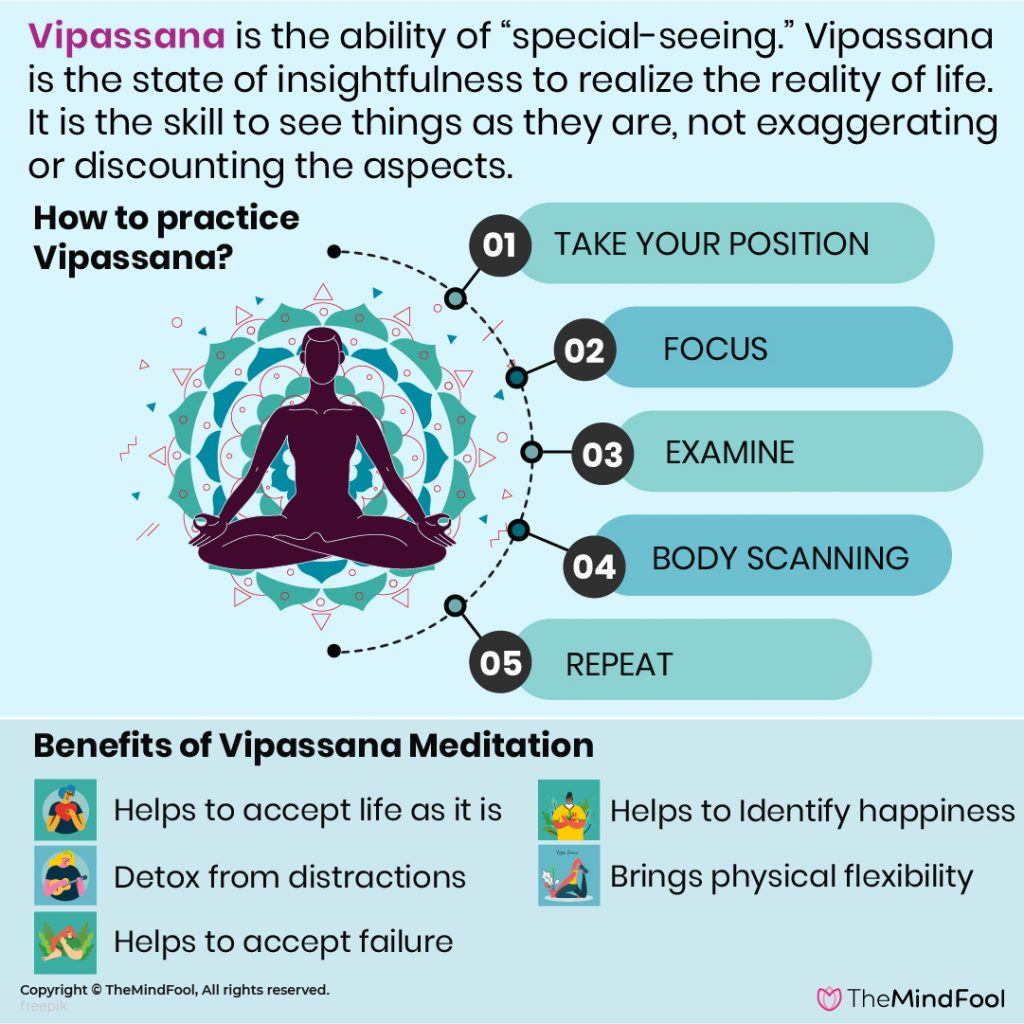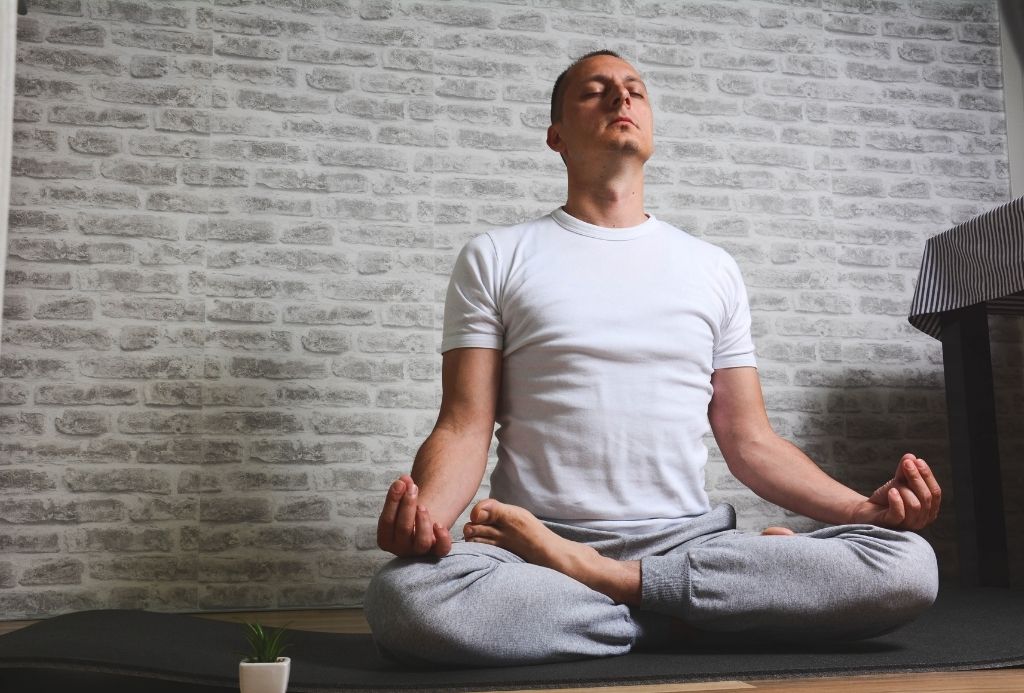
Vipassana meditation is becoming more and more popular in the West. An ancient Indian meditation technique that was lost over the years has reappeared with modifications. The new technique is aimed at the modern people who can practice it without taking refuge in a cave in the Himalayas! No, they can absolutely practice this form in the comfort of their homes.
What is Vipassana?
The term “Vipassana” originates from a Sanskrit term Vipaśyanā meaning the ability of “special-seeing.” The Buddhists use this term to describe the quality of our mind. Vipassana is the state of insightfulness or an ability to realize the reality of life. It is the skill to see things as they are, not exaggerating or discounting the aspects.
History of Vipassana Meditation
Vipassana meditation is considered as one of the most ancient meditation techniques in India. Gautama Buddha rediscovered this lost art and reintroduced about 2500 years ago. He resumed this meditation as a self-transformation technique. Through this meditation, one can free their impure minds and aim for complete liberation.
The Buddhist Theravada tradition of Vipassana started losing its essence in the 10th century. The meditation was rediscovered again in the 18th century in Myanmar. A Buddhist monk from Burma, Medawi authored manuals on Vipassana. This meditation regained its place in the 19th and 20th centuries in the Theravada countries.
Later the Vipassana movement or the American Vipassana movement occurred in the 20th century. Some of the American Buddhist teachers involved in this movement were – Joseph Goldstein, Gil Fronsdal, Tara Brach, and others. These western teachers combined the traditional Burmese method with other Buddhist and non-Buddhist techniques. Their intention was to popularize this meditation by simplifying the method.

What is Vipassana Meditation?
SUMMARY
Vipassana meditation is an ancient Buddhist meditation technique for calming the mind.
Vipassana, also called insight meditation, is an ancient Buddhist meditation practice. It originated from Satipatthana Sutta which is said to be started by Lord Buddha himself.
This method brings transformation to the practitioner. It is a gentle mindfulness tool that brings calmness to the mind.
In this meditative practice, you are given a set of awareness practices. Gradually, you become attentive to everything that is happening in your life. You now listen, speak, see, smell, touch, or even taste foods mindfully.
Vipassana meditation helps you to stay connected to life. You start observing life impartially and start enjoying every moment of it. As a result of daily meditative practice, you develop love and compassion for the world as well as yourself.
Bhante Henepola Gunaratana Mahathera, a Buddhist monk from Sri Lanka wrote a number of books on Vipassana meditation of which Mindfulness In Plain English is the one for common people to grasp the concept easily.
Theravada Vipassana
The Theraveda Vipassana tradition is ancient among other schools and it originated in South East Asia. This Vipassana school is rigid and follows the ancient practices without modifications.
Theraveda tradition is becoming a lost art because of the few teachers available. The Theraveda teachings on death and dying are not made available for everyone to learn.
Mahasi Sayadaw, Sayagyi U Ba Khin, and S.N. Goenka have modified the ancient practice and made it available worldwide.
Currently, America is the most important spot for Vipassana meditation and modern American teachers do not follow the age-old Theraveda practices.
How To Do Vipassana Meditation?
To practice Vipassana it is better if you enroll in a class. Here we are giving a step by step instruction and a video tutorial for you to get started.
Choose a room where you would not be disturbed. Switch off any electronic devices and follow these steps.
STEP I – TAKE YOUR POSITION
Sit comfortably in a straight-backed position. You can sit straight on a chair or cross-legged on the ground.
STEP II – FOCUS
Close your eyes and focus your attention on your breaths. Start taking deep breaths. Just observe how you inhale and exhale the air through your nostrils. Try to feel the physical sensations. How does the temperature change in your nostrils? You will not be able to feel much in your first sitting but that should be your goal.
With your breaths observe the rising and falling of your abdomen. The abdomen rises and again the falling of the abdomen occurs.
STEP III – EXAMINE
Now slowly move your attention from the breathing process to the top of your head. Examine any sensation happening there.
STEP IV – BODY SCANNING
Now gradually move down from your head to the different parts of your body. First focus on your neck, then progress down your body. Take a region, silently observe any sensations, and then move further down.
STEP V – REPEAT
Repeat the scanning process. A single sweep from head to toe can take anything between 10 to 30 minutes. Do not try to do the body scans fast. With practice, however, you will be able to do it in a short period of time.
Repeating the process is significant. You will develop an improved mindfulness with each repetition.
NOTE
It’s normal for your mind to wander while doing Vipassana meditation. Do not try to force your mind. Instead whenever you catch yourself thinking about something else, just ignore and bring back your focus onto the body part you were supposed to concentrate.
TIP
Don’t try doing Vipassana while lying on your bed as you might fall asleep. Always sit, straight-backed, and practice it.
Vipassana Experience
The Vipassana experience, as stated in the book Sapiens: A Brief History of Humankind – “People, are liberated from suffering not when they experience this or that fleeting pleasure, but rather when they understand the impermanent nature of all their feelings and stop craving them. This is the aim of Buddhist meditation practices. In meditation, you are supposed to closely observe your mind and body, witness the ceaseless arising and passing of all your feelings, and realize how pointless it is to pursue them. When the pursuit stops, the mind becomes very relaxed, clear, and satisfied.”
Vipassana meditation technique originated in India and is now popular in many countries all over the world. Learn Vipassana in a 10-day course offered by Dhamma.org. It is a form of art of living in which you will have to disconnect from all distractions and practice meditation.
According to Ivy Kwong, it was initially hard and tested her perseverance level but ultimately it was worth experiencing. She recommends having this experience. The 10-day silent retreat would be a unique experience for you, she confirms.
You can try the Vipassana experience for yourself. But it is also about the right timing. Do it only if you get a nudge from inside. You don’t have to choose it just because someone you know has gone for it.
If you are in a spiritual path and honestly looking for some answers about life, or if you are already practicing some form of meditation, you can try this course. And maybe after that, you can write a blog post sharing your experience!
Benefits of Vipassana Meditation
Those who completed a course are said to have experienced the benefits of Vipassana. The Government of India has introduced Vipassana for government officials because of its advantages. Vipassana centers have been started in several states of the country where the officials can take the Vipassana meditation course.
Here are ten benefits of Vipassana Meditation.
1. To accept life as it is

If you want to take only one important lesson from the Vipassana meditation technique, it has to be this. You will start accepting life situations as they are. Neither the happiest moments make you feel over joyous nor do the sad moments make you feel miserable. You will start to live your life without being too emotional. Vipassana allows its practitioners to take life as it comes.
From a participant of life, you become an observer. Now you will stop overreacting because there is no room for drama in your life. You will learn to watch life attentively and take action accordingly.
2. Nothing is permanent

In the ten days meditation retreats, you will learn impermanence as the only truth there is. Everything and everyone including you is temporary. Nothing exists forever and as you understand this great truth you become free.
You stop being attached to things or even people. Also, it makes it easier for you to cope up with grief or stressful situations because you know it will be over sooner or later.
3. Become mindful

Vipassana makes you fully aware of the environment. You start putting your attention to every detail whether you are eating or listening, working or meditating.
This mindfulness soothes your mind and slows its random movement. Your mind becomes calmer and focused.
4. Detox from distractions

When you do the Vipassana course, you will not be allowed to browse your phone, watch TV, or any other electronic devices for ten days. In fact, you would not be allowed to talk, make eye contact, read, or write for a full ten days.
That way, your focus will not get diverted to any external stimuli. The only thing your mind will be concentrating is meditation.
5. Accept failure

While doing the 10-day Vipassana meditation, you will fail naturally. It is difficult to keep your focus completely on meditation and quite normal for your mind to get swayed away. Still, you would be encouraged to continue with the practice.
Only those who have attained enlightenment are able to do this practice accurately. The other practitioners just keep trying. The strong determination will allow you to cope up with the daily challenges in your life.
You will accept failure as normal, only you have to keep on trying.
6. Identify happiness

Practicing Vipassana at a stretch can be painful. The body starts to revolt against your mental stamina. With each passing day, you might start questioning your discipline level. But after some days, it becomes normal. In the ten-day residential courses, people have life-changing experiences towards the end.
You start becoming more grateful in your daily life. When you appreciate everything in your life, you understand the true nature of happiness.
7. Stay calmer

The deep breathing techniques of Vipassana meditation quiet your body and mind. You become calmer and at peace from within.
Stress has no effect on you now. You simply observe such situations without reacting.
8. Become more efficient in the things you do

We do not reach our potential because our mind wanders all day long on unnecessary things. With this meditative practice, your mind becomes quieter. As a result, you start becoming more productive and utilize time effectively in your everyday life.
9. It’s all about your perspective

This meditative practice changes our perspective. One situation can be perceived in several ways. Different people will have different opinions.
Which is the correct opinion? Maybe all of the opinions are correct. This is why you should not bother about the opinion of others.
Instead of looking for a solution outside, Vipassana helps you to start looking for it inside.
Life changes as you give away the blame and start taking accountability for your actions.
10. Physical flexibility

The meditative practice involves rigorous physical exercises. As you sit cross-legged and practice hours of meditation it will enable your muscle flexibility. This practice is good for both mind and body.
Vipassana & Concentration
Vipassana is a technique of mindfulness, or it helps to balance your mind. Concentration, on the other hand, is a one-sided focus on one particular object or word or image.
Mindfulness and concentration are ancient techniques that go hand-in-hand in meditative practices. Although you must understand that the two are quite different.
For effective meditation practice, both mindfulness and concentration are required.
Mindfulness is a sensitive technique. Through this technique, you can observe things impartially. Concentration provides you the power to do so.
Concentration helps your mind to focus on a single item forcibly. When concentration is used for a good purpose you benefit. But instead, if you concentrate on negative intentions of harming yourself or others it is detrimental for you.
While concentrating your mind can get diverted and so true concentration is of rare occurrence. In that deep concentration, you are detached from all other thoughts except the one you are focusing on. Only advanced meditative practitioners can achieve this state.
Mindfulness, on the other hand, does not depend on any forced mental capacity. In fact, mindfulness cannot be achieved by force. This is a technique where you observe silently. You let go of the intention to control situations and just become aware. Obviously, this state has to be achieved through consistency.
Mindfulness has a broader function than concentration. Concentration ignores everything and revolves around one particular item. Whereas, mindfulness watches with a wide focus, standing back silently from the center of concentration.
Mindfulness is more difficult than concentration. It allows you to understand what you notice. While concentration has the power to dig deep into your mind but it does not realize what it sees.
The objective of mindfulness is to enable the learners to understand the impermanent, unsatisfactory, and selfless nature of life. It can set you free.
Vipassana is this practice of mindfulness which simply accepts whatever life is. Mindfulness grows stronger only by practicing mindfulness. It cannot be forced or rushed. The process of mindfulness will always proceed at its own pace.
Mindfulness allows the process of concentration or directs its power. In meditation, both of these are required. Only, it can be said that mindfulness is more crucial among the two techniques.
Difference Between Vipassana & other forms of Meditation
The Buddhist Meditation practices are mainly of two forms – Vipassana and Samatha. While Vipassana is based on insight or clear awareness, Samatha includes concentration or mental focus.
Vipassana is insight meditation whereas Samatha is a meditation of tranquility.
The most common types of meditation are based on Samatha. In this form, the meditator will focus on types of meditative objects of meditation such as – images, chants, particular items, prayers, or a candle flame to clear the mind.
To master Vipassana it takes years of practice. The meditator achieves a state in which he is not perturbed by any external influences.
Studies have shown both of these forms help the meditator to quiet their minds and improve their mental capacity. The ultimate goal for all forms of meditation is liberation. It is the stage when the spiritual transformation is complete.
Vipassana & Bhavana
Vipassana is a form of Buddhist meditations that involves mental training to achieve a state of mind to experience the world exactly as it is. You start observing things neutrally and your life starts to change.
Bhavana means to grow or cultivate. It is a form of mental cultivation. It helps the practitioner to see things in a new perspective to comprehend it fully.
In Pali, insight meditation is referred to as Vipassana Bhavana. It could be said that Vipassana allows you to become a silent observer of life, while Bhavana helps you to see things from a completely new perspective.
Disciplining Your Mind
To achieve success in any form of meditation you need to discipline your mind. Practicing concentration helps to train the restless mind.
There are several ways to do this.
• Gazing at an object for some time intently and then closing your eyes. Reopen your eyes. Again, look at the object and close it. Do this in a cyclical fashion.
• Keep chanting specific words or mantras.
• Focus on your breath.
The Final Goal of Vipassana
As you must have understood by now Vipassana is a completely different form of meditation. Here, the meditator is not opting for the concentration of the mind. Vipassana is not about sharpening your focus. It does not even try to achieve a thoughtless state of mind like most forms of meditation.
The final goal of Vipassana is freeing your mind from impurities. In Vipassana practice, your end goal is to achieve a state of mind in which the negativities and impurities are cleared away.
Nanak has said, “Until you know yourself, the mist of delusion does not disappear.” In Vipassana, therefore, you start with knowing yourself. Gradually you become self-aware, a devoted practitioner of mindfulness. When you achieve this goal the dirt of your mind or the negative qualities starts to dissolve. This is the ultimate objective of Vipassana.
Closing Thoughts
Vipassana is an ancient Indian meditation practice. It was adapted by Lord Budhha because it brings a state of insightfulness to the practitioner. Nowadays there are many courses on Vipassana and it has become widespread in the world especially in America. It helps you to become aware of life and attain a state of mind that is free of impurities and judgments.
Ishita is a published author, poet and freelance writer. Being an avid reader from early childhood, she has always loved books more than anything else in the world! At the start of her career, she has worked in the corporate as well as the academic sector being a double master's degree holder - M.Sc and MBA. But now she is a fulltime writer. She believes words have immense power and writers can make a huge impact in the world! She wants to bring positivity into the lives of the readers through her association with TheMindFool.
